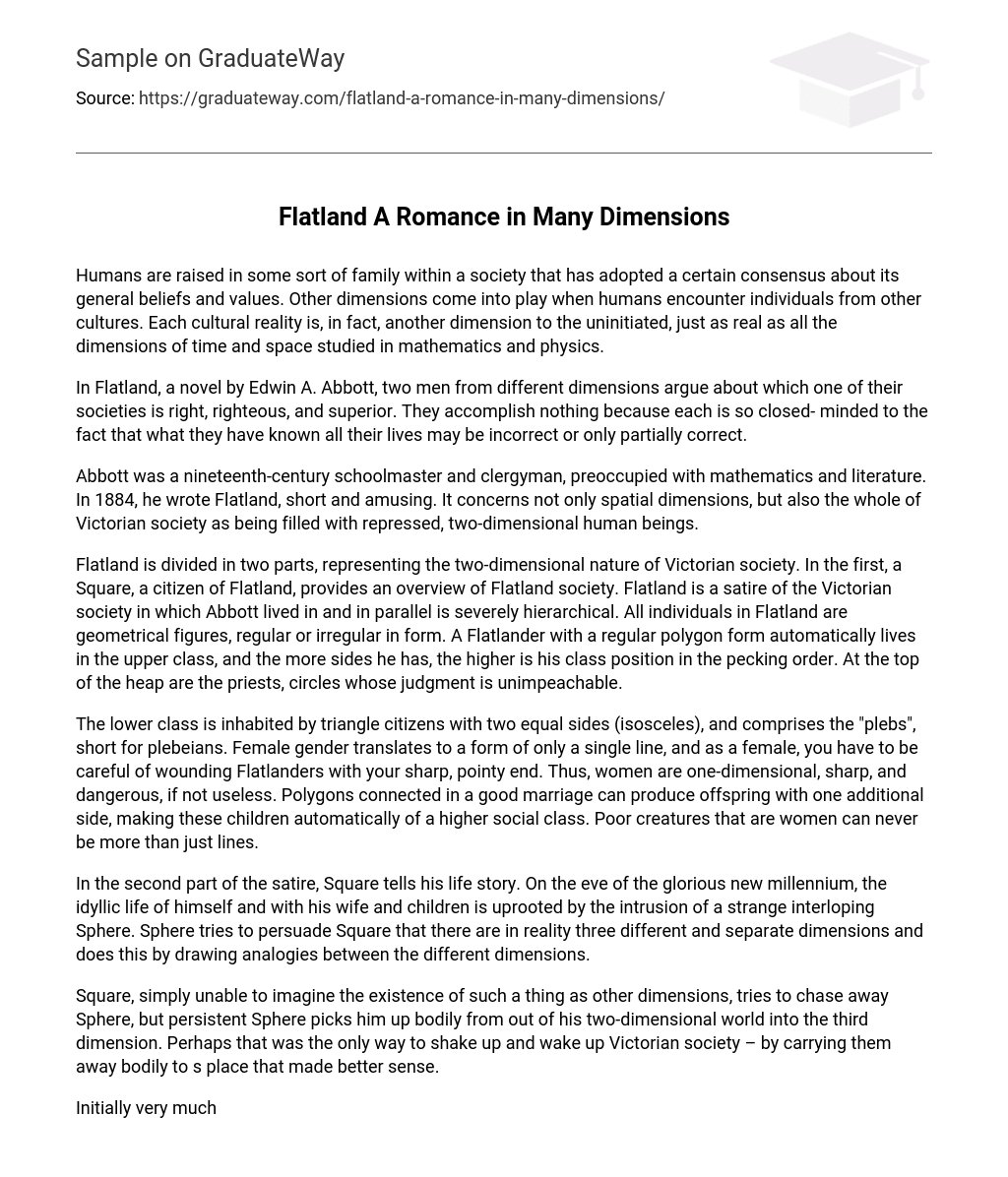Humans are raised in some sort of family within a society that has adopted a certain consensus about its general beliefs and values. Other dimensions come into play when humans encounter individuals from other cultures. Each cultural reality is, in fact, another dimension to the uninitiated, just as real as all the dimensions of time and space studied in mathematics and physics.
In Flatland, a novel by Edwin A. Abbott, two men from different dimensions argue about which one of their societies is right, righteous, and superior. They accomplish nothing because each is so closed- minded to the fact that what they have known all their lives may be incorrect or only partially correct.
Abbott was a nineteenth-century schoolmaster and clergyman, preoccupied with mathematics and literature. In 1884, he wrote Flatland, short and amusing. It concerns not only spatial dimensions, but also the whole of Victorian society as being filled with repressed, two-dimensional human beings.
Flatland is divided in two parts, representing the two-dimensional nature of Victorian society. In the first, a Square, a citizen of Flatland, provides an overview of Flatland society. Flatland is a satire of the Victorian society in which Abbott lived in and in parallel is severely hierarchical. All individuals in Flatland are geometrical figures, regular or irregular in form. A Flatlander with a regular polygon form automatically lives in the upper class, and the more sides he has, the higher is his class position in the pecking order. At the top of the heap are the priests, circles whose judgment is unimpeachable.
The lower class is inhabited by triangle citizens with two equal sides (isosceles), and comprises the “plebs”, short for plebeians. Female gender translates to a form of only a single line, and as a female, you have to be careful of wounding Flatlanders with your sharp, pointy end. Thus, women are one-dimensional, sharp, and dangerous, if not useless. Polygons connected in a good marriage can produce offspring with one additional side, making these children automatically of a higher social class. Poor creatures that are women can never be more than just lines.
In the second part of the satire, Square tells his life story. On the eve of the glorious new millennium, the idyllic life of himself and with his wife and children is uprooted by the intrusion of a strange interloping Sphere. Sphere tries to persuade Square that there are in reality three different and separate dimensions and does this by drawing analogies between the different dimensions.
Square, simply unable to imagine the existence of such a thing as other dimensions, tries to chase away Sphere, but persistent Sphere picks him up bodily from out of his two-dimensional world into the third dimension. Perhaps that was the only way to shake up and wake up Victorian society – by carrying them away bodily to s place that made better sense.
Initially very much horrified, Square begins to wake up and smell the dimensions of life as it were, and becomes increasingly more enthusiastic about the beautiful things he observes beyond the two dimensions in which he was raised. However, he cannot be satisfied with this experience. Square decides that there should be even more dimensions than three, and begins an argument with Sphere, who suddenly seems very shortsighted in dimensional matters.
Square is plopped back into his two-dimensional reality, and decides to spread the gospel word about the existence of multiple dimensions to all the people of Flatland. In Victorian, straight-laced, tunnel-visioned Flatland, these heretical notions caused him more trouble than he could accept, and the arguments continued ad infinitum. In the continuing story, Square and the Monarch of Lineland are both still closed-minded to the possibility of other worlds or multiple ways of seeing things different from their own experiences, Square’s now including three or more dimensions. Outside Lineland all was nonexistent according to the Monarch and when Square tried to explain to him that the universe was made up of three and more dimensions, the Monarch called these suggestions impossible. Neither man could begin to accept the possibility that his world and his beliefs could be in any way inferior to those of the other. Neither would budge, so the gospel fell on deaf ears.
Flatland is much fun to read and makes us poke fun at ourselves once we recognize ourselves in its pages. It may always be relevant to current society, no matter how far advanced it may have become, because there is always further to go, and another dimension to climb. About 100 years old, it is still a popular scientific work and a biting, relevant social satire at once, much like mathematician Lewis Carroll’s Alice in Wonderland, or even more so.
There have been many who tried to follow Abbott, however, with only a mathematical goal. In fact, a sequel to Flatland exists and is called Sphereland. In these more recent types of books, the higher dimensions are explored in a popular way, with some focus on visualizing higher dimensions via drawing of analogies. This is compelling and interesting, because imagining higher spatial dimensions seems to be impossible for many individuals. With the advances of computerization and the Internet, virtual reality may be of a substantial assistance in accomplishing this.
REFERENCES
Abbott, Edwin A. Flatland: A Romance in Many Dimensions. 1884. Copyright expired.





